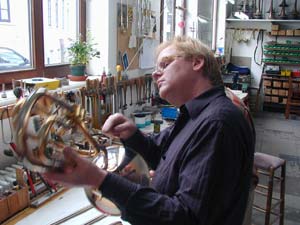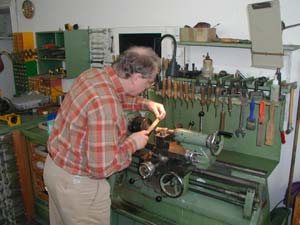You have never heard the terms lubrication groove, Pitchfinder, and Sliding Bell before? No problem, the brothers Max and Heinrich Thein (at work in their workshop) explain all technical terms:


- Lubrication groove
This valve bearing system was developed by Meinlschmidt and provides an uninterrupted lubrication of the cylinder valve via a groove in the valve cylinder. - French rim
Brass/steel wire with a round cross-section is beaded and soldered at the bell end. This is the most common rim. See picture. - English rim
Abrass/nickel silver half-round wire (semicircular cross-section) is beaded and soldered at the bell end. This provides a brighter sound. - “Mainzer” rim
A brass/nickel silver half-wire (semicircular cross-section) is beaded and soldered at the bell end and cut flush. This adds a good pithiness to the sound. - Garland rim
A brass or nickel silver ring (1 to 7 cm wide) is placed on the bell end. A brass or steel wire is worked into the end of this ring. The garland is placed on the bell and the bell end is beaded. In rare cases the garland is soldered. The garland is the historical bell construction of the Renaissance and Baroque, when the bells were forged on a matching form and their wall thickness decreased towards the bell end. The advantage of this rim is that it focuses the sound to the fortissimo. - Thein “Kruspe-style” metal
In the 19th century, the original Kruspe metal was preferred for trumpets and trombones among many brass alloys. It has a high copper content. Thein carried out a metallurgical analysis of this no longer available alloy and revived it. - Quart valve
The three normal valves lower the fundamental tone of the instrument by a half tone (usually the 2nd valve), by a whole tone (1st valve) and by 1 1/2 tones (3rd valve).
An additional quart valve lowers the fundamental tone by 2 1/2 tones. For details about the advantages see the comment by Matthias Höfs in the list of instruments. - Quint crook
A quart valve can be equipped by an additional quint crook. This forms a quint valve which lowers the fundamental tone of an instrument by 3 1/2 tones. - Sliding Bell System
The bell is slidable and therefore acts as a tuning facility. As a positive side-effect, the bell can be exchanged. But it was mainly developed for sound reasons. Whenever two pipes do not directly touch each other, there is a change in the pipe diameter which influences the sound – similar to trombones where the pipe diameter changes permanently. These so-called “air pockets” influence the feeling and the sound of the instrument. - Yellow brass
Yellow brass is the standard material. It contains 58 to 72% copper. At a copper content of more than 80% it is referred to as gold brass (also Tombak in Austria), at a copper content of over 90% it becomes red copper which is hardly usable for instruments. - Pitchfinder
This is a tuning facility soldered onto the main tuning slide. The fundamental pitch is tuned first, and then it can be changed flexibly. This is also possible as a combined trigger with the 3rd valve. It is especially helpful while playing in an orchestra when the player has to start after a long rest with a cold instrument. In this case, the instrument can be flexibly tuned up until the normal playing temperature is reached and the instrument has recovered its “tuned” intonation. To a certain degree, this can be compared to the intonation of a trombone via the slide. The advantage lies in the fact that even in a “cold” condition or with a “tired” embouchure the instrument can be played in the centre and does not have to be “bent” to the required pitch. - Sound ring
This slidable metal ring, which adds to the centering and mass of the tones, was developed from the historic reference to the “knob” of the baroque trumpet.
See “Half-round and pearl bars”. - Overblowing key (B/C/A)
The instrument is shortened “acoustically” by a key, and the more remote lower tone of the natural tone series of a virtually shorter instrument is used.
This increases the accuracy in the upper range. - Sound plate
This is similar to the sound ring. But the sound plate adds weight across the surface. The additional material also gives a higher wall thickness and centers the sound accordingly. - Half-round and pearl bars
Our studies of historic instruments have shown that there is no single component which is mere decoration. Similar to the sound ring, we developed half-round bars and pearl bars which can be sticked on (for testing) or soldered to the instrument. These bars influence the response and radiation. Plain bars provide a darker sound while pearl bars increase the surface area and influence the radiation. - Zirnbauer machine
In contrast to the Meinlschmidt machine, the pipes are soldered, which gives clearly different results in terms of sound. - Meinlschmidt machine
This is the standard machine for rotary valve trumpets. - Combined trigger
On 4 valve machines the 3rd and 4th valve are triggered simultaneously via a combined trigger.

